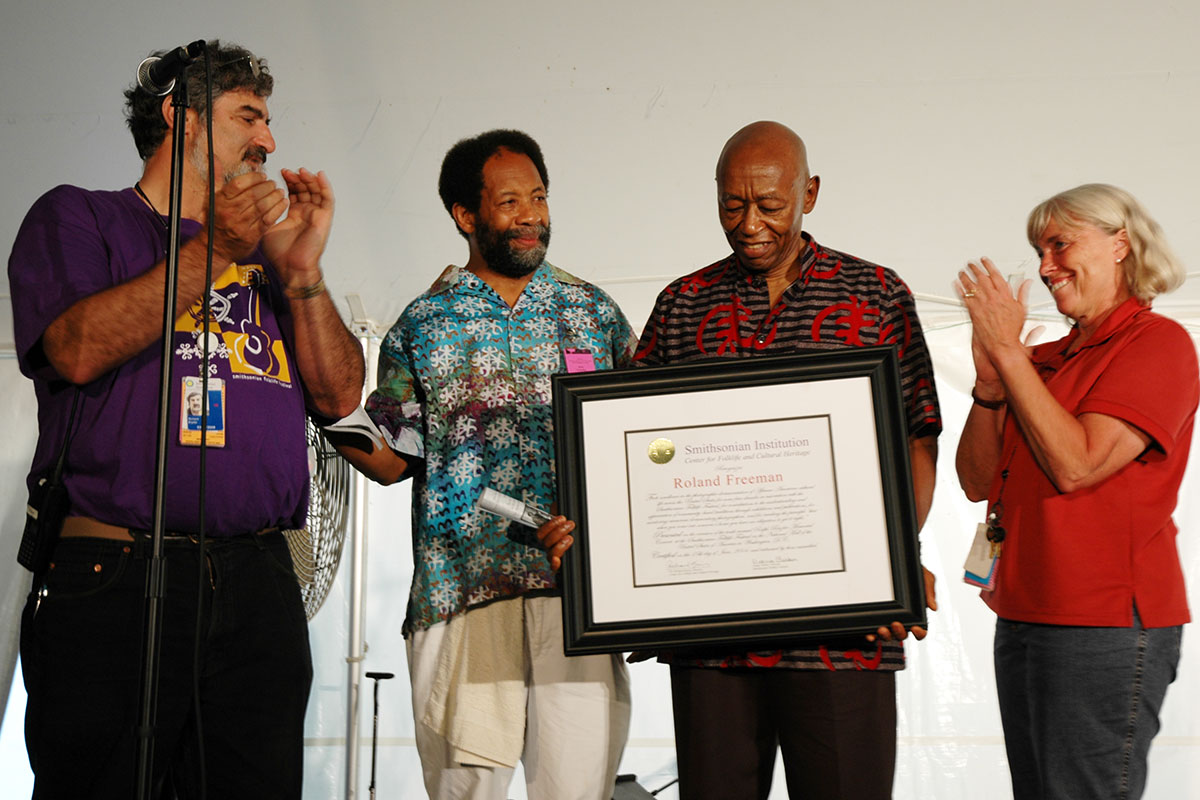“Ritchad, we gotta do a tribute to Worth.”
“Ritchad, we gotta do quilts for Obama.”
“Ritchad, we gotta make sure the Arabbers are at the Festival.”
Such entreaties were among dozens in calls I received from Roland Freeman in his distinctive verbal style over several decades—each one compelling, cogent, and compassionate. Many came to be, and the Smithsonian and our nation are the better for it.
Roland Freeman, a longtime Center for Folklife and Cultural Heritage research associate, was tremendously accomplished—as a photographer, documentarian, author, organizer, exhibition producer and curator, folklorist, educator, and quilt collector. Roland passed in August, at age eighty-seven, and his obituary in the Washington Post includes many of his achievements, as does a release by the National Endowment of the Arts, which had honored Roland as a National Heritage Fellow in 2007.
I inherited a good part of the Smithsonian’s relationship with Roland from previous directors Ralph Rinzler and Peter Seitel when I came permanently to what is now the Center in the mid-1980s. I had first worked at the Festival of American Folklife (now Smithsonian Folklife Festival) in 1976 and was aware of the legendary effort of the Roland Freeman-Worth Long duo in crafting the Mississippi program for 1974 and its follow-up Mississippi Folklife Project.


Roland was always ready to go with projects. It was always projects. I thought he was restless—in the best of ways, just like Ralph. Roland wanted to do justice to people, especially those who had suffered, been devalued and ignored. He thought Black folk had something to say, something to contribute and teach their neighbors and the rest of the country—some wisdom, some beauty, some lessons of and for humanity. He thought he could best represent their gifts, insights, and ways of doing—and making do—with a camera. I was taken and sometimes, like others, overtaken by Roland’s compelling persistence and righteousness, but it was all well-founded and thought out. Roland had a philosophy and methodology, and I and others learned from him.
These themes came through at a recent memorial for Roland at the Washington, D.C., Friends Meeting House in November. Marcia Freeman, Roland’s beloved wife for more than half a century, spoke movingly and amusedly about their first meeting and their life together. Her account, and those of friends, mentees, and colleagues—including Worth Long and Center curator Diana N’Diaye—had much in common even though their experiences with Roland spanned many chapters of his life.
All lauded Roland as a careful and committed documentarian. He brought curiosity, accuracy, and precision into his work. He knew about his topics and subject matter, and, of course, the people. He would tell me, to take a picture, he needed to understand the people he was representing. It wasn’t only the physical image within the frame, he would say, but it was important to know what a quilter was looking at when she quilted and capture that connection even though it wouldn’t physically show in the final photograph. You had to know the context and setting of the quilting—what she thought about while stitching, what memories she would call upon, and so on. Roland got that information through detailed conversations in order to really understand—and make a better photograph.

Roland often talked about shooting in black and white, and how the tones of color film—at least in its early decades—did no justice to African Americans, as it distorted skin tones. So compelling was his argument that National Geographic agreed to publish one of his photo essays in black and white rather than in color as was typical. Earlier this year, UNC-Chapel Hill’s University Libraries acquired Roland’s extensive archive—including 10,000 prints, 400,000 negatives—as part of its Southern Folklife Collection.
Above all, Roland would tell me, “When you come into someone’s home, you gotta get it right.” What a clear statement about ethics, care, and respect for those being represented, whether at the Festival, in an exhibition, or in a book. It was just his way of being. Maybe it was a result of his upbringing in Baltimore and rural Maryland and life’s lessons ranging from service in the Air Force to the front lines of the civil rights movement, but, for me and many others, it marked an approach that we took as enduring guidance and aspiration.
Roland was always attentive, sometimes even obsessed with the impact of his work. He knew it was good and important and could be life-changing in many ways. I remember when we mounted the Stand By Me exhibition at the African American Museum in Philadelphia—some photographs of which continue to grace the Center’s office walls. It was joyous to see folks Roland had photographed coming to the museum, many for the first time ever. They were so proud. They felt important, that their life had extra special meaning because Roland had taken the time and effort to be with them and represent them. Roland, his work never done, personally guided people through the exhibition, asking them all what they thought—had he gotten it right?
I hope Roland is in heaven, but somehow I cannot see him resting in peace. I imagine he has projects he wants to do, even there. And if anyone is able to snap a picture of heaven, it will be Roland, and I am fully confident he will get it right!

Richard Kurin is the Smithsonian distinguished scholar and ambassador at large, and formerly served as acting director and director of the Center for Folklife and Cultural Heritage.


